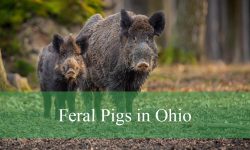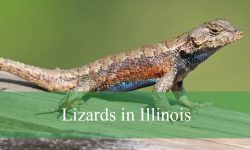Missouri is home to a rich variety of birdlife, and among its most striking residents are the many species of herons found across the state. These long-legged wading birds are commonly seen near rivers, lakes, marshes, and wetlands, where they hunt for fish, frogs, and insects. Exploring the different types of herons in Missouri reveals a fascinating range of sizes, colors, and behaviors that reflect the diversity of the region’s ecosystems.
Some herons are tall and majestic, like the Great Blue Heron, while others are smaller and more secretive, such as the Green Heron or the night-active Black-crowned Night-Heron. Each species has its own preferred habitat and feeding style, from patiently waiting in shallow water to darting quickly for prey. The changing seasons also affect their presence, with some species found year-round and others appearing only during migration or summer breeding.
This article highlights 12 unique types of herons in Missouri, complete with identification details and helpful photos. Learning about these species not only enhances your birdwatching skills but also deepens your connection with Missouri’s natural landscapes and the wildlife they support.
Different Types of Herons in Missouri
Great Blue Heron (Ardea herodias)
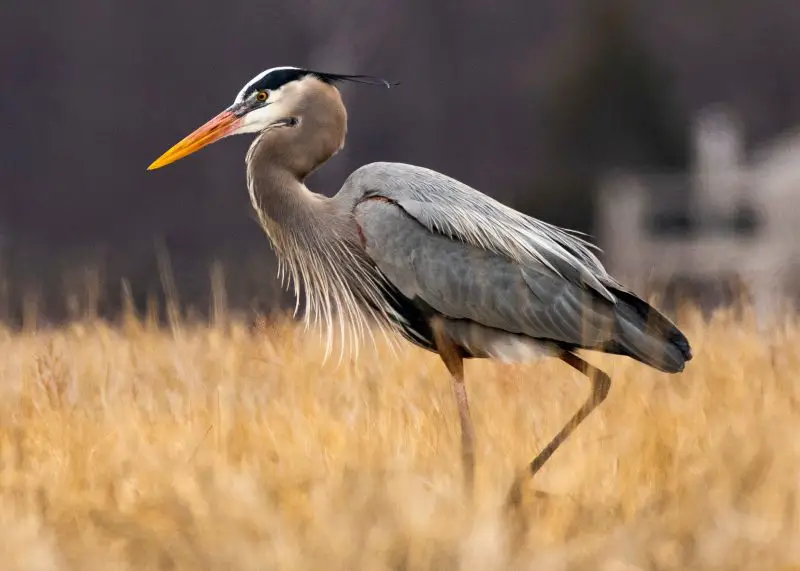
The Great Blue Heron is the largest heron species in North America, standing about 4 feet (1.2 meters) tall with an impressive wingspan reaching nearly 6 feet (1.8 meters). It has long, thin legs adapted for wading in water and a distinctly S-shaped neck that aids in striking prey with its sharp, yellow bill. The bird’s plumage is primarily a slate-blue color with black plumes on the head and a subtle rust-colored accent on the thighs. In flight, its slow wingbeats and tucked-in neck create a graceful and unmistakable silhouette.
This heron is a patient hunter, often seen standing motionless in shallow water waiting to ambush prey such as fish, amphibians, small mammals, insects, and crustaceans. Its stealthy approach and lightning-quick strikes make it an efficient predator. Great Blue Herons typically forage alone, though they may nest in colonies called rookeries, often high in trees near water. Their nests are large, made of sticks, and reused year after year.
In Missouri, the Great Blue Heron can be found year-round and is especially common near rivers, lakes, marshes, and large ponds. During warmer months, breeding populations are widespread across the state, and in winter, some individuals remain near ice-free water bodies in the southern regions. The species is well adapted to a variety of aquatic habitats, both rural and urban.
Green Heron (Butorides virescens)
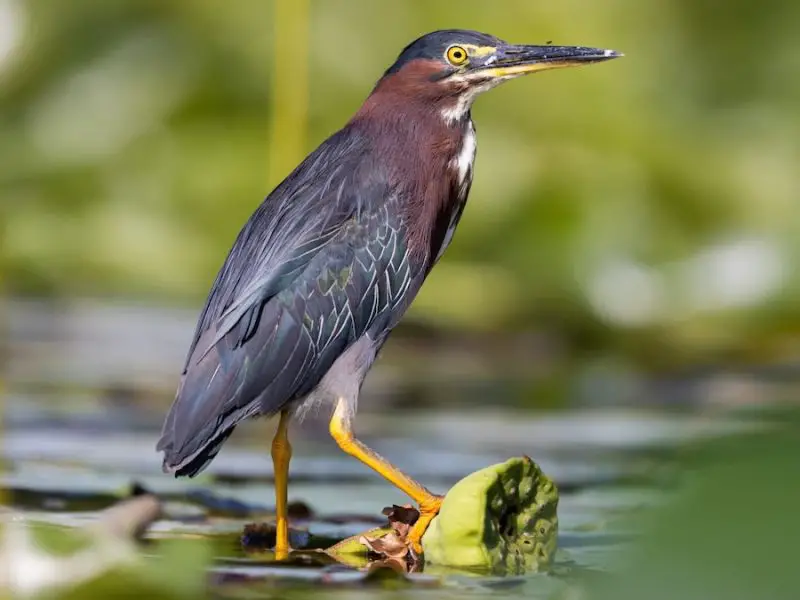
The Green Heron is a small but striking bird, measuring about 16–18 inches (40–46 cm) in height with a wingspan of around 25 inches (64 cm). Adults have a glossy greenish-black cap and back, rich chestnut-colored neck and breast, and bright yellow or orange legs. Their eyes are intense yellow, and their short, stocky bodies make them look more compact than other heron species. When alarmed, they stretch their necks and appear much taller than usual.
Unlike many other herons, Green Herons are solitary and secretive, often hiding in dense vegetation along the edges of streams, ponds, and marshes. They are one of the few bird species known to use tools—placing insects, feathers, or twigs on the water’s surface to lure fish within striking distance. They feed primarily on small fish, aquatic insects, frogs, and crustaceans, using a sit-and-wait technique while perched silently on a branch or log.
In Missouri, Green Herons are typically found during the breeding season from April to October. They prefer wooded wetlands, overgrown ponds, slow-moving creeks, and small lakes where vegetation provides good cover. Though not as conspicuous as larger herons, they are fairly common in suitable habitats throughout the state during warmer months.
Black-crowned Night-Heron (Nycticorax nycticorax)

The Black-crowned Night-Heron is a stocky, medium-sized heron with a body length of about 23–28 inches (58–71 cm) and a wingspan of up to 45 inches (114 cm). Adults are easily recognized by their black crown and back, gray wings and body, and piercing red eyes. They have relatively short legs and necks compared to other herons, giving them a hunched appearance when at rest. Juvenile birds are brown with white streaks, making them look quite different from the adults.
As their name suggests, Black-crowned Night-Herons are most active at dusk and during the night. They often roost in trees or dense vegetation during the day and forage for food in shallow waters after dark. Their diet includes fish, frogs, insects, and crustaceans, and they may also scavenge when food is scarce. These herons are known for their loud, barking “quawk” call, especially when disturbed.
In Missouri, Black-crowned Night-Herons are present during the breeding season, commonly found in wetlands, marshes, lake edges, and along forested riverbanks. They often nest in colonies, sometimes with other wading birds, building stick nests in trees or shrubs. Though not as widespread as Great Blue Herons, they are a regular sight in suitable habitats, particularly near large wetlands in the northern and central parts of the state.
Yellow-crowned Night-Heron (Nyctanassa violacea)

The Yellow-crowned Night-Heron is a slightly smaller and less common cousin of the Black-crowned Night-Heron, measuring about 22–28 inches (56–71 cm) in length with a wingspan around 44 inches (112 cm). Adult birds have a distinctive appearance with a pale yellow crown stripe, slate-gray body, and red eyes. Their thick neck, robust bill, and upright stance give them a unique and almost regal look. Juveniles are brown with white spotting and resemble immature Black-crowned Night-Herons but can be distinguished by subtle plumage differences.
This heron specializes in feeding on crustaceans, especially crayfish and crabs, using its strong bill to crack through shells. It forages mostly at night or during low-light hours, usually in marshes, forested wetlands, or tidal flats. It is less gregarious than some other herons and often seen alone or in small groups. Despite its reserved habits, the Yellow-crowned Night-Heron has a loud, harsh call that is sometimes heard at dusk.
In Missouri, Yellow-crowned Night-Herons are typically summer residents, with breeding populations concentrated in the southeastern parts of the state. They favor bottomland forests, swamps, and riverside thickets with abundant crayfish populations. While they are less widespread than other herons in the state, they are a fascinating species for birders lucky enough to encounter them.
Little Blue Heron (Egretta caerulea)

The Little Blue Heron is a medium-sized heron, measuring about 24 inches (61 cm) in height with a wingspan of roughly 40 inches (102 cm). Adult birds have slate-blue plumage with a maroon-brown head and neck during breeding season, along with dull greenish legs. Juvenile Little Blue Herons are entirely white and can be mistaken for Snowy Egrets, but they have dark bills and greenish legs instead of black and yellow. As they mature, juveniles go through a patchy phase with mixed white and blue feathers.
This species prefers shallow freshwater or brackish wetlands and is often seen stalking prey such as small fish, frogs, insects, and crustaceans. They forage slowly and deliberately, usually alone or in small groups, and sometimes associate with mixed flocks of other waders. During feeding, they may sway their necks or use subtle foot-stirring to flush prey from muddy or vegetated waters.
In Missouri, Little Blue Herons are primarily seen from late spring through early fall, especially in the southern and eastern parts of the state. They inhabit marshes, flooded fields, and riverbanks, and are more commonly found during migration periods. Though less abundant than the Great Blue Heron, they are a regular sight in productive wetland areas during the warmer months.
Tricolored Heron (Egretta tricolor)
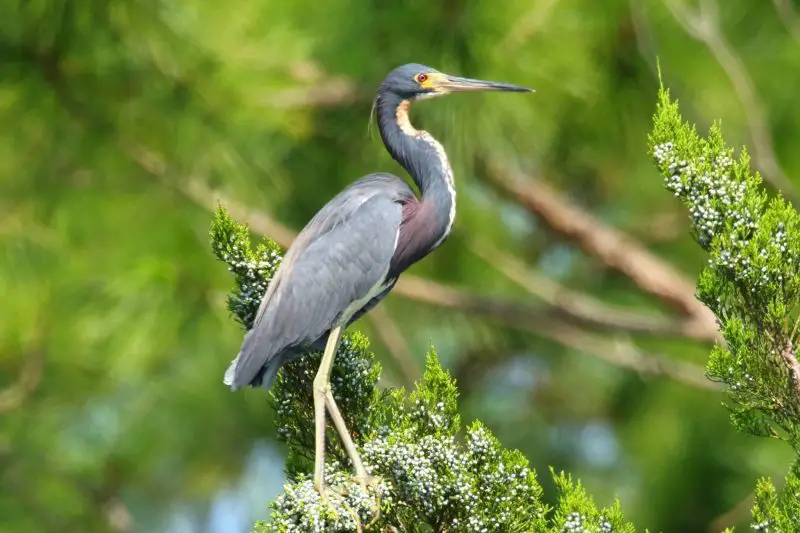
The Tricolored Heron is a slender and graceful bird with distinctive plumage that sets it apart from other herons. It features a slate-blue back and wings, a white belly and undertail, and reddish-brown highlights on the neck. This three-toned coloration gives the species its name. With a body length of about 26 inches (66 cm) and a wingspan of up to 36 inches (91 cm), it is slightly smaller and more delicate in appearance than the Great Blue Heron. Its long, pointed bill and thin, yellowish legs are adapted for wading and hunting in shallow water.
This heron typically inhabits coastal wetlands, marshes, and estuaries in the southeastern United States. It prefers warm, brackish environments and is often found in saltwater lagoons or mangrove swamps, where it feeds on small fish, amphibians, and crustaceans. Tricolored Herons are active and animated foragers, frequently seen darting through shallow water with quick steps and sudden lunges to catch prey. They usually forage alone and may display territorial behavior during feeding.
In Missouri, the Tricolored Heron is considered a rare and accidental visitor. Most sightings are attributed to birds that have wandered far from their usual range, often during migration periods or after storms. While not part of the state’s regular avian population, it has occasionally been recorded in the southeastern lowlands or wetland preserves. Birdwatchers who spot one in Missouri have encountered a true rarity, making it a notable addition to any birder’s state list.
Cattle Egret (Bubulcus ibis)
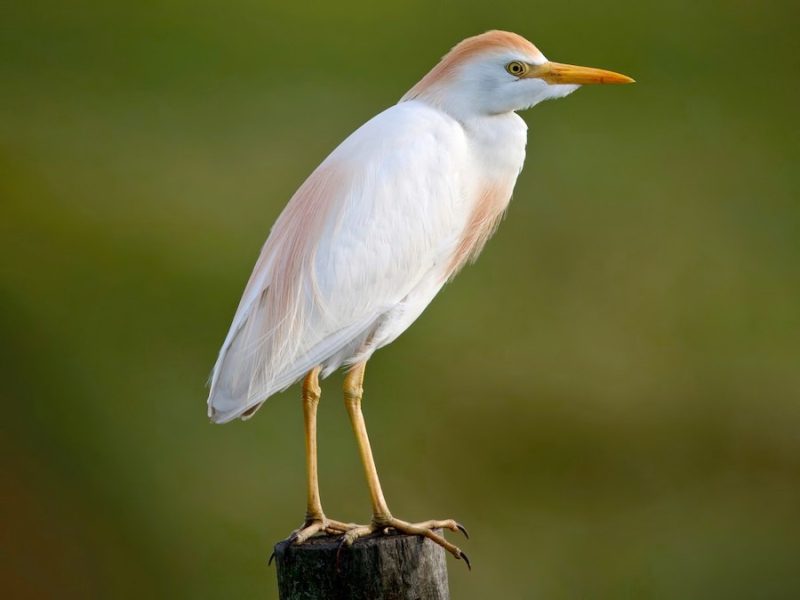
The Cattle Egret is a small, stocky heron known for its close association with livestock. Standing around 18–22 inches (46–56 cm) tall with a wingspan of about 36 inches (91 cm), this species is mostly white with a short yellow bill and relatively short legs compared to other herons. During the breeding season, adults develop buff-orange patches on their head, chest, and back, along with bright red or pinkish facial skin and legs, giving them a striking appearance.
Cattle Egrets are often seen in fields, pastures, and agricultural lands, where they forage for insects and other small creatures stirred up by grazing animals. Their diet primarily includes grasshoppers, crickets, flies, and other invertebrates, though they will also consume frogs and small mammals when available. Unlike many wading birds, they are frequently observed far from water, and their habit of following cattle or farm machinery has earned them their common name.
In Missouri, Cattle Egrets are seasonal migrants, arriving in spring and staying through the summer months. They are most commonly found in rural areas, especially in open fields and meadows near livestock operations or hayfields. Though less tied to aquatic environments than most herons, they still roost and nest near water, often in colonies with other wading birds. Their adaptability and opportunistic feeding behavior make them a familiar sight in Missouri’s countryside during the warmer seasons.
Snowy Egret (Egretta thula)

The Snowy Egret is a striking white heron known for its delicate features and striking contrast in leg coloration. It stands about 24 inches (61 cm) tall and has a wingspan of approximately 41 inches (104 cm). Its pure white plumage is accented by slender black legs and vivid yellow feet, often described as “golden slippers.” During the breeding season, Snowy Egrets also develop long, elegant plumes on the back of the head, neck, and back, which were once highly sought after for fashion, nearly driving the species to extinction in the early 1900s.
This species is a skilled and active forager, often seen running through shallow water, flicking its feet to stir up prey such as small fish, insects, and crustaceans. Snowy Egrets feed alone or in mixed flocks, sometimes displaying aggressive behavior to defend feeding territories. Their sharp, black bills and quick reflexes help them catch fast-moving prey, and their graceful movements make them a favorite among birdwatchers.
In Missouri, Snowy Egrets are typically present during the warm months, particularly from late spring through early fall. They are most often seen in wetlands, flooded fields, and along the edges of lakes and rivers. Though not as abundant as the Great Egret or Great Blue Heron, their numbers have rebounded due to protective legislation and conservation efforts. Today, they can be found in scattered locations across the state, especially in the southeastern and central lowland wetlands.
Great Egret (Ardea alba)
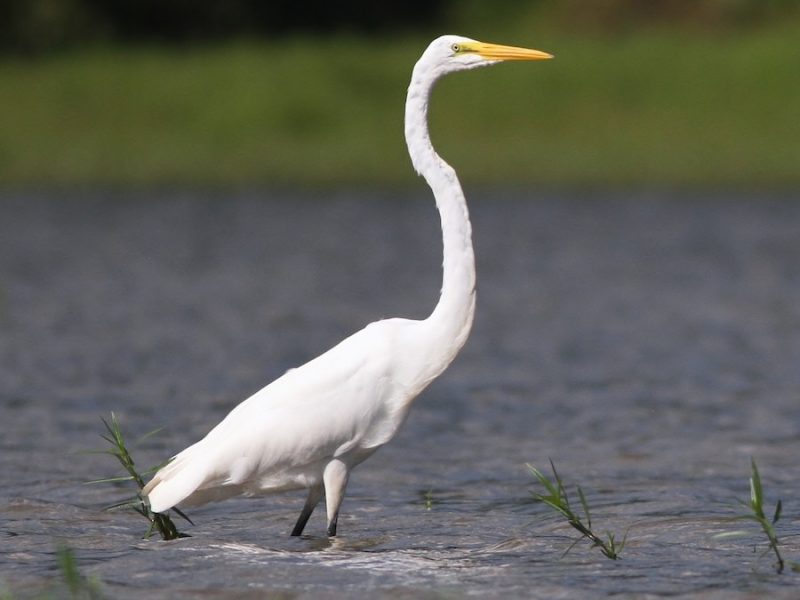
The Great Egret is one of the most elegant and recognizable wading birds in North America. It is entirely white, with a long, slender neck and an impressive height of up to 40 inches (1 meter), making it nearly as large as the Great Blue Heron, though its body is slimmer and more delicate. Its yellow, dagger-like bill and black legs help distinguish it from similar species. During the breeding season, adults develop delicate ornamental plumes on their backs, which they raise in courtship displays.
This species is a patient and stealthy hunter, often seen standing still for long periods in shallow water as it waits for fish, frogs, or aquatic insects to approach. It uses its long neck in a rapid thrusting motion to spear prey with its sharp bill. Great Egrets may forage alone or alongside other wading birds, especially in nutrient-rich marshes and wetlands. They nest colonially, often in tall trees near water, frequently in mixed rookeries with other heron species.
In Missouri, the Great Egret is a seasonal visitor, typically arriving in spring and remaining through the summer. It is commonly found in wetland areas, along riverbanks, lake shores, and especially within protected waterfowl refuges and conservation areas. Although not as abundant as the Great Blue Heron, the Great Egret’s large size, striking appearance, and graceful movements make it a favorite among birdwatchers across the state.
Reddish Egret (Egretta rufescens)

The Reddish Egret is one of the rarest and most distinctive herons that may be observed in the United States, known for its two color morphs: a dark phase with slate-blue body and reddish head and neck, and a white phase that resembles the Snowy Egret. Its long, shaggy neck feathers and bicolored bill—black at the tip and pink at the base—make it especially eye-catching. This medium-sized heron stands about 27 inches (69 cm) tall and is built for quick, agile movements in shallow water.
What sets the Reddish Egret apart from other herons is its highly animated foraging behavior. It actively hunts by running, spinning, and even flapping its wings to startle fish in the water. This erratic and energetic hunting style contrasts sharply with the still, patient tactics of most herons. Reddish Egrets primarily feed on small fish and crustaceans and are typically found in coastal lagoons, tidal flats, and brackish marshes in the southern United States, especially in Texas and Florida.
In Missouri, the Reddish Egret is an accidental and extremely rare visitor, usually only recorded during exceptional displacement events or storms. Its presence in the state is highly unusual and unpredictable, making any sighting a significant event for local birders. When it does appear, it is most likely to be seen in southeastern Missouri wetlands during late summer or early fall migration periods.
Little Egret (Egretta garzetta)
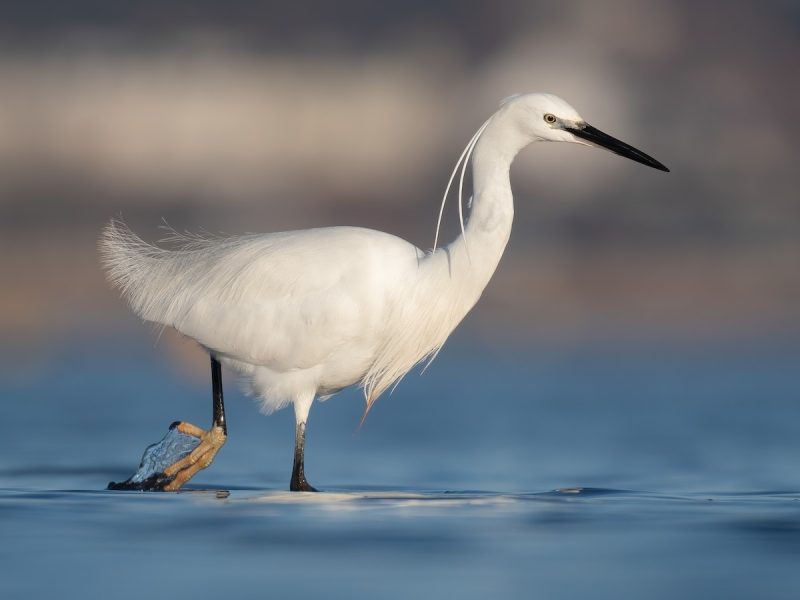
The Little Egret is a graceful white heron that closely resembles the Snowy Egret, with fine plumes on its head, neck, and back during the breeding season. It has a black bill, black legs, and bright yellow feet, and it measures about 24 inches (61 cm) in height with a wingspan near 41 inches (104 cm). Although it is native to Europe, Asia, and parts of Africa, it has occasionally appeared in North America as a vagrant, causing considerable excitement in the birding community.
This species prefers shallow wetlands, tidal flats, and coastal lagoons, where it forages actively for fish, amphibians, and invertebrates. It may hunt alone or in loose flocks and often uses foot-stirring techniques to flush prey from muddy or sandy bottoms. Its elegant foraging style and elaborate breeding plumage have made it a symbol of beauty in avian photography and conservation campaigns.
In Missouri, the Little Egret is not a regular visitor and is considered a very rare vagrant. Sightings are exceedingly scarce and are often subject to review for verification due to the difficulty in distinguishing it from the Snowy Egret. If a Little Egret is observed in the state, it becomes a highly notable event, drawing birders from across the region in hopes of seeing a species that is more commonly associated with the Old World.
Western Reef-Heron (Egretta gularis)
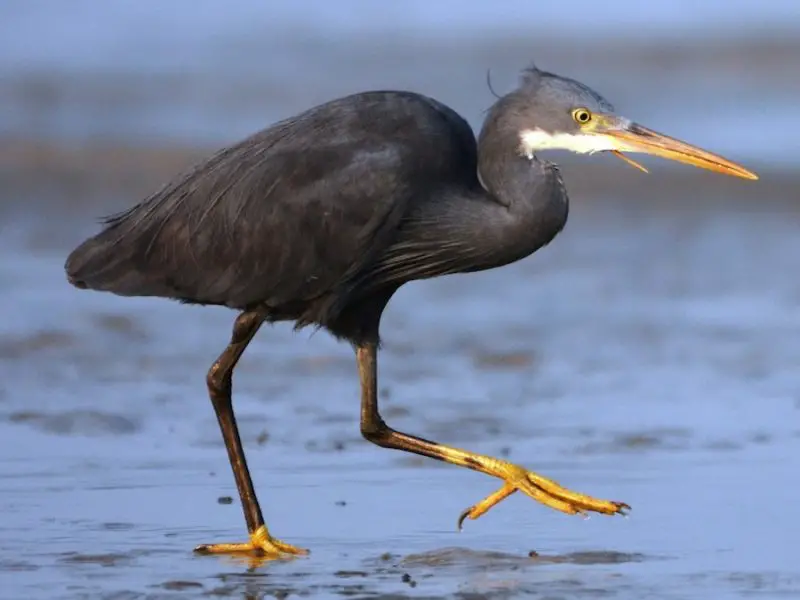
The Western Reef-Heron is a rare and exotic-looking wading bird that comes in both white and dark gray morphs, with the dark form being more frequently seen. It has a slender body, yellow feet, and a dark, slightly decurved bill. Closely related to the Little Egret, the Western Reef-Heron measures around 22–26 inches (56–66 cm) in length. It is primarily distributed along the coastlines of western Africa, the Middle East, and parts of southern Asia, particularly India and Sri Lanka.
This species typically inhabits tidal flats, mangroves, and coral reefs, where it hunts for fish, crabs, and other small aquatic animals. It uses a stealthy stalking method, moving slowly through shallow water or crouching low before striking with its sharp bill. Western Reef-Herons are solitary foragers but may gather in small groups at roosting sites. Their flexible feeding habits allow them to adapt to various coastal ecosystems, especially areas with rocky or sandy substrates.
In Missouri, the Western Reef-Heron is not officially recorded and remains an unofficial vagrant at best. However, it has been documented in the eastern United States, especially along the Atlantic Coast, where a few individuals have appeared sporadically. Due to its similarity to the Little Egret and Snowy Egret, positive identification can be challenging without clear photographic evidence. If ever spotted in Missouri, it would represent an extraordinary and perhaps unprecedented record in the state’s ornithological history.


